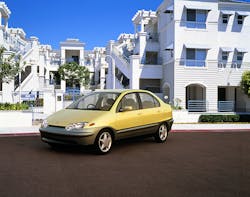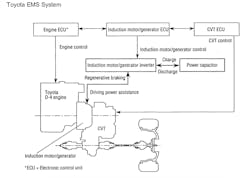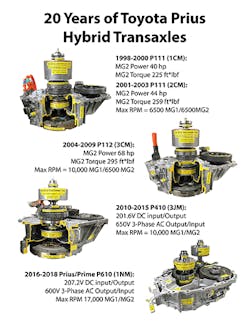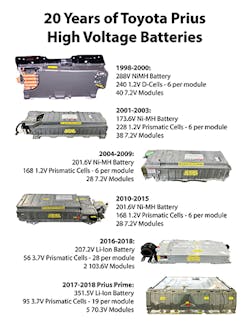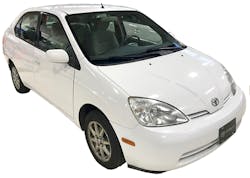Has it really been 20 years since the first Toyota Prius was released? Yes, it was launched in Japan in December 1997 as a 1998 model. The Prius was launched in the U.S.A. in the summer of 2000 as a 2001 model. The Prius is now in its fourth generation. Whether or not you like the Prius, almost every other hybrid vehicle on the market today contains parts that were obviously patterned after the first Toyota Hybrid System (THS) in the first Prius. This was the world’s first mass produced hybrid vehicle, and it shocked the entire automotive industry upon its launch.
The development of the first Prius is an incredible story that is detailed in a 387-page book called The Prius that Shook the World by Hideshi Itazaki, published in 1999. Unfortunately, that book is out of print. I was able to find a used one on Amazon several months ago. I was able to get permission from Mr. Itazaki to share some of the information from his book with you. I will also share additional information I have collected over the years.
Why did Toyota build the Prius? According to my research, a combination of four factors inspired the development of the Prius.
-
EPA Laws: In 1990, amendments were made to the U.S. Environmental Protection Agency’s (EPA) Clean Air Act of 1970. The automotive industry was directly impacted by new rules to reduce acid rain, reduce urban air pollution, and reduce toxic air emissions.
-
CARB Laws: Also, in 1990, the California Air Resources Board (CARB) adopted the Zero Emission Vehicle (ZEV) mandate. Both of these changes in laws affected the ability of an automobile manufacturer to sell cars in California without meeting the new regulations by 1998-2003.
-
Inequality: Further inspiration to build the Prius came from inequality of enforcement of U.S. laws. Toyota had already experienced situations where U.S. fuel economy and emissions laws were enforced on Japanese auto makers, while granting extra time to the Big-3 from Detroit to find ways for their cars to meet the requirements. Toyota Motor Corporation took these new regulations seriously.
- Pride: Because of inequality and probably some personal pride. Toyota Engineers decided they wanted to show people in the U.S.A. that a car can be practical, attractive, clean, and fuel efficient. They wanted to beat the Big-3 from Detroit to market with such a car.
G21 Project: In September of 1993 Toyota formed the Globe 21st Century (G21) project to research what the car of the future would look like, how it would operate, and how polluting it would be. The following ideas for a concept car resulted from the project: 1. It would have a roomy cabin with a high seat position. 2. Use an aerodynamic body design. 3. Achieve 20 km/L (47 mpg) fuel economy (50% Better than the car of the day). 4. Use a horizontally mounted efficient engine with direct fuel Injection. 5. Use an efficient Continuously Variable Transmission (CVT). 6. It would be a vehicle with no increased infrastructure requirements (unlike electric and Compressed Natural Gas (CNG) vehicles).
To make a long story short, the G21 project went through several phases as progress towards the development of a concept car from scratch proceeded. In late 1994, Toyota management decided that a 50% increase in fuel economy was not enough for a car of the 21st century, they directed the G21 group to double the fuel economy instead.
A concept car (Figure 1) was built for the October 1995 Tokyo Motor Show. The car was built with an electric induction motor/generator sandwiched between a direct injected 1.5L gasoline engine and a push-belt CVT transmission. A capacitor was used to store, and release, energy as required. This system was described as the Toyota-EMS (Energy Management System – Figure 2) rather than a hybrid. Toyota wanted it kept secret that they were developing a hybrid vehicle.
Toyota Hybrid System: As a result of the directive to double fuel economy, the G21 project group had to change everything; a new powertrain design had to be developed. In June of 1995, at the final meeting of the G21, development of a hybrid vehicle was officially approved at the meeting and a code name " 890T" was assigned to the Prius. Toyota was determined to keep the development of their hybrid vehicle a secret. The hybrid system was named "Toyota Hybrid System (THS). Development of the new THS system presented many challenges. Most of the following challenges had never been accomplished in the automotive industry. Toyota had to pioneer the design of each of these from scratch.
Atkinson Cycle Engine: Rather than using the direct injected gasoline engine (Otto Cycle), it was decided to develop an Atkinson Cycle gasoline engine because of its high efficiency and low exhaust emissions. The Atkinson cycle engine was better suited to work with the new transaxle design. As you may know, the Atkinson cycle engine leaves the intake valve open for a short period of time during the compression stroke. This action, effectively reduces the compression ratio in the cylinder.
The Atkinson cycle engine had two unique problems when used with the hybrid system. Both problems were solved by adding Variable Valve Timing with Intelligence (VVT-i), but not for the traditional reasons of improved performance. The first problem was the jolt of starting and stopping the engine while the car was moving. The jolt was reduced by using the VVT-i to leave the intake valves open for a longer period of time than usual to decrease cylinder pressures under those conditions.
The second problem involved starting the engine when cold. Remember, a non-Atkinson cycle engine always has lower compression ratios which makes cold starting difficult. The addition of the VVT-i system allowed the intake valve to be temporarily closed early causing higher cylinder compression and easier cold starting. This engine would eventually become known as the Toyota 1NZ-FXE.
Transaxle (Figure 3): The push belt CVT transaxle was dropped as an option because it was more difficult to start and stop the engine when the car is in motion. They decided to develop a Power Split Twin Electric Motor/Generator Electronic CVT (E-CVT) transaxle instead. If you recall, the power spit design uses a single planetary gear set. The planet carrier is connected to the engine’s crankshaft, the sun gear is connected to Motor Generator 1 (MG1), and ring gear is connected to the traction motor (MG2). The power split design allows the engine to contribute torque to the traction motor to help propel the vehicle. This transaxle would eventually become known as the Toyota P111.
P111: The P111 (1CM model) and P111 (2CM Model) transaxles had a single Power-Split Device (PSD) Planetary Gear Set and a chain driven final drive.
P112: The P112 (3CM model) transaxle was almost identical to the P111 (2CM); however, a change to the design of MG2 resulted in 9 percent more motor torque.
P410: The P410 (3JM) transaxle has two planetary gear sets: A (PSD) set and a new Motor Speed Reduction (MSR) set. The MSR increased the MG2 motor torque 2.63 times through gear reduction. As a result, MG2 motor speed increased to a maximum of 10,000 RPM. A gear drive replaced the chain driven final drive of the previous models.
P610: The P610 (1NM) transaxle was a new efficient design, but it operates identically to the P410 with a (PSD) planetary gear set and a (MSR) gear set and a maximum of 17,000 RPM.
Inverter/Converter (Figure 4): As you may know, the inverter uses power from the high voltage DC battery to drive each of the 3-phase AC electric motors in the transaxle through 6 Insulated Gate Bi-polar Transistors (IGBT). The IGBTs also contain a diode which is used to help rectify 3-phase high voltage back to DC voltage during deceleration and while the engine is running. IGBTs had never been developed for this power level and high operating temperature. Toyota had to design their own IGBTs in-house. The high under hood temperatures caused by the engine running made the design more difficult. It was a very long and frustrating process, but Toyota set the benchmark for IGBTs and inverters that others use to this very day.
If you have ever heard that the Prius does not have any power, it came from the 1998-2003 Prius. The 1998-2003 THS inverters did not use a boost converter to increase system voltage above battery voltage. These models were not well suited for mountainous driving. At times, customers would complain of a lack of power driving up a long uphill grade with a fully loaded vehicle. There was actually a “Turtle Light” that would come on to indicate the battery energy was depleted and to drive less aggressively to let it recover.
Beginning with the 2004 model year, to remedy the lack of power complaints, a boost converter was added to the inverter. This would more than double the voltage applied to the transaxle MG2 motor to drive the vehicle. The combination of the boost converter, transaxle modifications, and better aerodynamics was called the Toyota Hybrid Synergy Drive (HSD). These vehicles do not lack power, they are very fun to drive.
Further enhancements in 2010 and above were named the Toyota Hybrid Synergy Drive-II (HSD-II).
High Voltage Battery (Figure 5): It is hard to imagine this today, but the Nickel-Metal Hydride (Ni-MH) battery was a relatively new technology in the early 1990s: Toyota had already co-developed a Ni-MH battery with Matsushita Battery Co. for the 1994 RAV4 EV but developing the Prius battery was going to be more challenging.
There were two big problems with the Prius battery development: 1. Excessive Heat: They tried placing the battery under the car (like the Rav4 EV), but the battery got too hot from the additional heat produced by the engine and from the road. Finally, they decided to put the battery in the trunk behind the back seat to solve the overheating problems using air cooling. 2. Power output: The Prius battery was supposed to supply 288 Volts and 20 kW of power. The early designs of the battery did not have the capacity output needed for the Prius to meet the directive to double fuel economy. The first battery was also about twice the size allowed for the space in the Prius.
In December of 1996, after failing to produce a satisfactory battery for the Prius, Toyota partnered with Matsushita electric and Matsushita Battery in a joint venture to form Panasonic EV Energy company (Figure 6). The battery for the first Prius was made of 240 round D-Cell 1.2V Ni-MH cells all connected in series in a box behind the back seat. There were many production problems resulting from tiny specs of lint contaminating the battery cells internally. Poor connections between each of the 240 cells was also an early concern. These issues were solved just in time for the December 1997 launch of the 1998 Prius.
The 2001 model and later Prius battery designs used flat prismatic battery modules in place of the older D-cell designs. Panasonic EV Energy is the supplier of Ni-MH batteries for all four generations of the Prius as well as some Honda and General Motors hybrids.
The 2016 and later Prius 207.2V battery used 2 stacks of twenty-eight 3.7V Li-ion cells in place of the older Ni-MH modules. The 2017 and later Prius Prime 351.5V battery used 5 stacks of nineteen 3.7V Li-ion cells for electric only driving and then the vehicle switches to hybrid mode.
Four Separate Cooling Systems: The 1998 Prius hybrid required four separate cooling systems: One for the engine, one for the combination of the inverter and the transaxle, one for the air conditioning, and one for the high voltage battery. That meant that three radiators were needed to fit where two would have normally been placed. It was decided to combine two radiators (the engine and the inverter) into one unit. This style of radiator system is still used in the latest Prius today.
Regenerative Braking System: Stopping a hybrid vehicle under all possible conditions presented many new challenges. Toyota engineers had to figure out how, and when, to blend hydraulic braking and regenerative braking from the motor/generators. They had to make this brake system feel like any other vehicle’s braking system would. They had to simulate how the brake pedal felt while it was being depressed. They even engineered a creep forward feeling when the brake pedal was released to simulate what a car with an automatic transmission does. All of these systems had to be developed from scratch.
Introduce it to the World: After only 2.5 years of development time using 1000 engineers, the 1998 Prius is shown to the world press in October and finally offered for sale at Japan Toyota dealerships on December 10, 1997. This real-life hybrid vehicle shocked the press and the automotive industry, especially the Detroit Big 3. Toyota showcased the Prius at the January 1998 Detroit Auto Show. The Big-3 auto makers displayed non-functional concept cars and announced that they would have superior hybrids and fuel cell vehicles on the road in 2-3 years (which has never happened in the last 20 years).
The 1998 Prius looked almost identical to the 2001-2003 Prius (Figure 7). It had right hand drive, no rear spoiler, and six spoke wheels. It looks nothing like the later models of the Prius.
Initial sales orders of the 1998 hybrid Prius were three times what were predicted in Japan over the next three years. Toyota decided to release The Prius to the rest of the world in 2000, but only after several modifications were made to give it more power and make it more reliable.
Today the Toyota Hybrid System and its variations have found their way into 40 other Toyota and Lexus vehicles over the last 20 years. It has become the best-selling and most efficient hybrid system in the market with over 10.4 Million hybrid vehicle sales worldwide. The Prius of today would shock the original G21 group. The Prius has exceeded all of the G21 goals established in 1993 except for the use of gasoline direct fuel injection (GDI), but Toyota just announced a new GDI hybrid engine earlier this year, so more changes are on their way.
After 20 years of the Toyota Prius, are you familiar with how they work, how to diagnose and repair them, how to service them? If not, it has been 20 years! It is time to get started before you fall behind in the ever-changing world of hybrid and electric vehicle technology. Best wishes!
